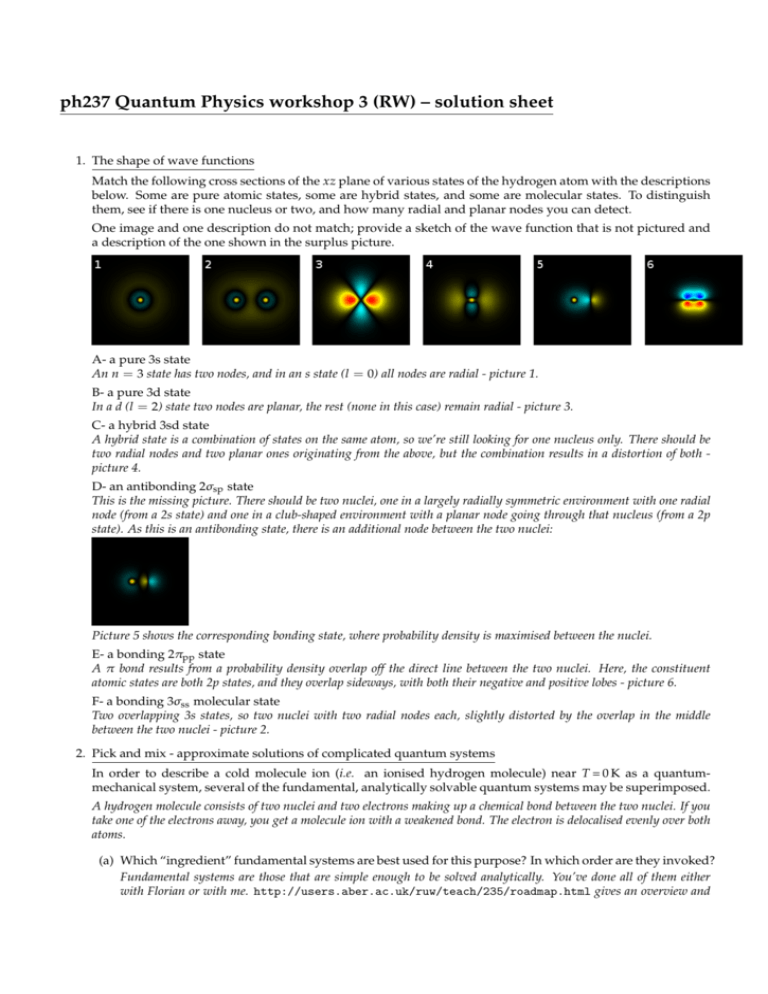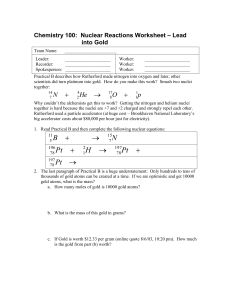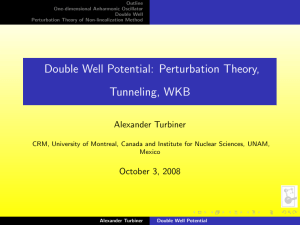ph237 Quantum Physics workshop 3 (RW) – solution sheet
advertisement

ph237 Quantum Physics workshop 3 (RW) – solution sheet 1. The shape of wave functions Match the following cross sections of the xz plane of various states of the hydrogen atom with the descriptions below. Some are pure atomic states, some are hybrid states, and some are molecular states. To distinguish them, see if there is one nucleus or two, and how many radial and planar nodes you can detect. One image and one description do not match; provide a sketch of the wave function that is not pictured and a description of the one shown in the surplus picture. A- a pure 3s state An n = 3 state has two nodes, and in an s state (l = 0) all nodes are radial - picture 1. B- a pure 3d state In a d (l = 2) state two nodes are planar, the rest (none in this case) remain radial - picture 3. C- a hybrid 3sd state A hybrid state is a combination of states on the same atom, so we’re still looking for one nucleus only. There should be two radial nodes and two planar ones originating from the above, but the combination results in a distortion of both picture 4. D- an antibonding 2σsp state This is the missing picture. There should be two nuclei, one in a largely radially symmetric environment with one radial node (from a 2s state) and one in a club-shaped environment with a planar node going through that nucleus (from a 2p state). As this is an antibonding state, there is an additional node between the two nuclei: Picture 5 shows the corresponding bonding state, where probability density is maximised between the nuclei. E- a bonding 2πpp state A π bond results from a probability density overlap off the direct line between the two nuclei. Here, the constituent atomic states are both 2p states, and they overlap sideways, with both their negative and positive lobes - picture 6. F- a bonding 3σss molecular state Two overlapping 3s states, so two nuclei with two radial nodes each, slightly distorted by the overlap in the middle between the two nuclei - picture 2. 2. Pick and mix - approximate solutions of complicated quantum systems In order to describe a cold molecule ion (i.e. an ionised hydrogen molecule) near T = 0 K as a quantummechanical system, several of the fundamental, analytically solvable quantum systems may be superimposed. A hydrogen molecule consists of two nuclei and two electrons making up a chemical bond between the two nuclei. If you take one of the electrons away, you get a molecule ion with a weakened bond. The electron is delocalised evenly over both atoms. (a) Which “ingredient” fundamental systems are best used for this purpose? In which order are they invoked? Fundamental systems are those that are simple enough to be solved analytically. You’ve done all of them either with Florian or with me. http://users.aber.ac.uk/ruw/teach/235/roadmap.html gives an overview and the revision sheet, http://users.aber.ac.uk/ruw/teach/235/03235 revision.pdf, re-iterates this. It’s no use to list them all in a question such as this; the point is that you need to select the relevant ones, i.e. those that the system you want to solve by approximation has some resemblance of. Here, we have two atoms which can be treated as either two H atoms or as two 3D Coulomb wells (but not as one of each, as the two atoms are equivalent) which are combined by LCAO. If you want, you can add a harmonic oscillator to represent the vibration of the bond, although this wouldn’t be active at T = 0 K. A rigid rotor isn’t needed since no rotation would change the relative positions of the atoms within the molecule. Only relative atom positions matter because if the whole molecule rotates, we can just rotate its reference frame with it, and no energy changes occur. For the same reason, a translation of the whole molecule is irrelevant. (b) Choose a suitable reference frame and sketch the geometry of the system and its position in the reference frame. Let d be the bond length. A reference frame in 3D space consists of three co-ordinates and an origin. The co-ordinates can be lengths or angles. Generally, it is a good idea to exploit as much symmetry as you can. The best reference frame here is cylindrical (z, r, φ), with the axis along the bond connecting the two atoms and the origin in the middle between the atoms, i.e. in the centre of gravity. With questions like this, always think about the symmetry of the object you want to study, and use a frame that supports that symmetry. (c) Plot the potential against each of the three coordinates of your chosen reference frame (keeping the other coordinates constant). Note that nuclei and electron have opposite charges, so the potential is attractive, and there are potential minima at the positions of the nuclei. (d) Explain how the treatment of the system would change if the temperature was higher. Vibration is activated (so you’ll need to add a harmonic oscillator if you haven’t already done so), and the electron may be excited into a higher-n state on either atom. 3. Perturbation - the anharmonic oscillator Mathematical techniques to derive Schrödinger solutions (i.e. eigenfunction/eigenvalue pairs) for new systems from solutions for known systems include the variation and perturbation techniques. (a) Explain the difference between the harmonic and the anharmonic oscillator models. Illustrate the need for the anharmonic correction by reference to the vibration states of a linear two-atom molecule. The anharmonic oscillator takes into account that the potential softens as the bond length widens, i.e. it becomes easier to separate the two atoms further as the separation increases. This is equivalent to extending a spring beyond the elastic range, where Hooke’s law applies. Mathematically, this is realised by addding higher-order polynomial terms to Hooke’s law. (b) Calculate the 1st order energy correction (1) En = Z ∞ −∞ (0)∗ ψn (0) Ĥ1 ψn dx of the anharmonic oscillator. Use the perturbation Ĥ1 = cx3 + dx4 for this purpose. Note: Z ∞ 0 2n −bx2 x e 1 · 3 · · · (2n − 1) dx = 2n+1 r π b2n+1 We need to apply the perturbation to the unperturbed wave function of the harmonic oscillator, which is ψ = ke−αx (1) En = = = Z ∞ (0)∗ 2 /2 (0) Ĥ1 ψn dx 2 2 ke−αx /2 cx3 + dx4 ke−αx /2 dx −∞ Z ∞ 2 2 k e−αx cx3 + dx4 dx −∞ Z ∞ ψn −∞ = ck 2 Z ∞ −∞ 2 x3 e−αx dx + dk2 Z ∞ −∞ 2 x4 e−αx dx 2 The first integral contains a product of an odd function (x3 ) and an even function (e−αx ), which combined is an odd function. The infinite integral over any odd function is zero because of the inversion symmetry of the function at the origin (see http://users.aber.ac.uk/ruw/teach/340/ft symmetry.html for detailed explanation). The other integral contains an even function, so the infinite integral is twice its semi-infinite integral, and we can use the mathematical hint above with n = 2: = = Z ∞ 2 x4 e−αx dx 0 r π 2 3 2dk 3 2 α5 √ 3dk2 π 4α 5/2 = 2dk2 (c) The 1st order term in perturbation theory is (0) (0) ( Em − En ) Z (0)∗ (1) (1) ψm ψn dx = En Z (0)∗ (0) ψm ψn dx − Z (0)∗ (0) ψm Ĥ1 ψn The energy correction calculated above comes from the m = n case. What is the physical significance of the m 6= n case? The m 6= n case can be used to calculate perturbed wave functions. rw/090327 .










